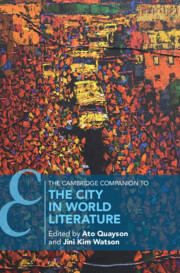Book contents
- The Cambridge Companion to the City in World Literature
- The Cambridge Companion to the City in World Literature
- Copyright page
- Contents
- Contributors
- Chronology of Political, Literary, and Cultural Events
- Chapter 1 Introduction
- Part I Critical Approaches
- Part II Spotlight Literary Cities
- Chapter 5 The Neighborhood and the Sweatshop
- Chapter 6 “The Whole World in Little”
- Chapter 7 Unworlding Paris
- Chapter 8 Sketching the City with Words
- Chapter 9 Romance and Liminal Space in the Twentieth-Century Cairo Novel
- Chapter 10 Bombay/Mumbai and its Multilingual Literary Pathways to the World
- Chapter 11 At Home in the World
- Chapter 12 Imagining the Migrant in Twenty-First Century Johannesburg
- Chapter 13 Russia
- Chapter 14 “Cityful Passing Away”
- Chapter 15 From Altepetl to Megacity
- Chapter 16 (In)Visible Beijing Within and Without World Literature
- Chapter 17 Worlding Lagos in the Long Twentieth Century
- Chapter 18 Haunted Vitality
- Select Bibliography
- Index
- Cambridge Companions To …
Chapter 8 - Sketching the City with Words
Istanbul Through Time in Turkish Literary Texts
from Part II - Spotlight Literary Cities
Published online by Cambridge University Press: 13 July 2023
- The Cambridge Companion to the City in World Literature
- The Cambridge Companion to the City in World Literature
- Copyright page
- Contents
- Contributors
- Chronology of Political, Literary, and Cultural Events
- Chapter 1 Introduction
- Part I Critical Approaches
- Part II Spotlight Literary Cities
- Chapter 5 The Neighborhood and the Sweatshop
- Chapter 6 “The Whole World in Little”
- Chapter 7 Unworlding Paris
- Chapter 8 Sketching the City with Words
- Chapter 9 Romance and Liminal Space in the Twentieth-Century Cairo Novel
- Chapter 10 Bombay/Mumbai and its Multilingual Literary Pathways to the World
- Chapter 11 At Home in the World
- Chapter 12 Imagining the Migrant in Twenty-First Century Johannesburg
- Chapter 13 Russia
- Chapter 14 “Cityful Passing Away”
- Chapter 15 From Altepetl to Megacity
- Chapter 16 (In)Visible Beijing Within and Without World Literature
- Chapter 17 Worlding Lagos in the Long Twentieth Century
- Chapter 18 Haunted Vitality
- Select Bibliography
- Index
- Cambridge Companions To …
Summary
A complex tapestry of interwoven themes spanning many centuries, Istanbul is a kaleidoscopic patchwork, a city of polar contrasts, and we are not lost for ways to explore the city and its denizens of times past. Istanbul is a city of the mind, an imaginary space that spurred writers and poets to document it in not only Turkish literature but also literature from many other cultures. Ottoman-Turkish literature alone portrays the rich andheterogeneous imagery of Istanbul ina variety of genres, including poems, plays, chronicles, memoirs and novels, and this article explores that literary tradition. It draws upon selected works that range from the Ottoman conquest of the city in 1453 up until the early 19th century, and then beyond that time when a burgeoning print culture grew, when new literary forms arose such as novels, plays and short stories. Authors of the selected texts comprise writers and poets such as Latifi, Zaifi, Fikri Çelebi, Gelibolulu Ali, Veysi, Evliya Çelebi, Nedim, Badr al-Din al-Ghazzi, Muhammad Kibrit, Tevfik Fikret, Ahmet Hamdi Tanpınar, İlhan Berk and Orhan Pamuk. Most of these authors’ works suggest that, unlike other great cities of the world, one’s perception of Istanbul is rooted somewhere within one’s soul.
Keywords
- Type
- Chapter
- Information
- The Cambridge Companion to the City in World Literature , pp. 115 - 130Publisher: Cambridge University PressPrint publication year: 2023



